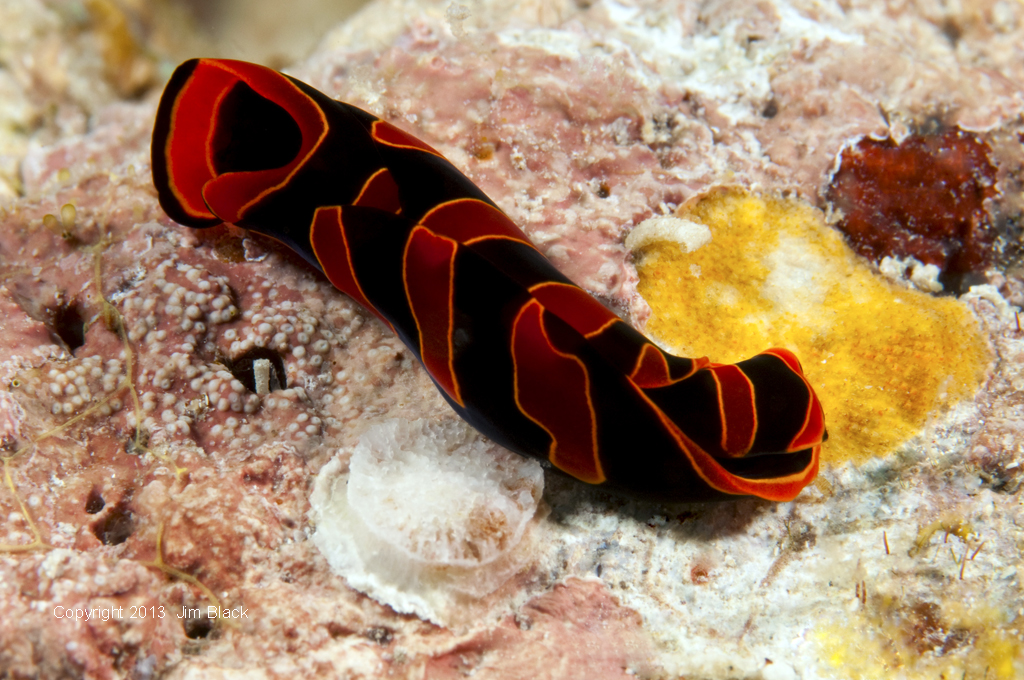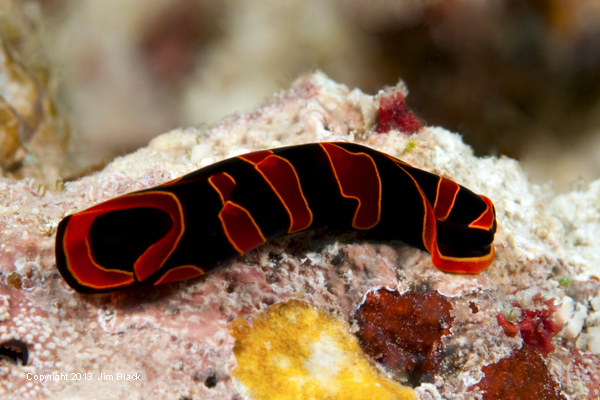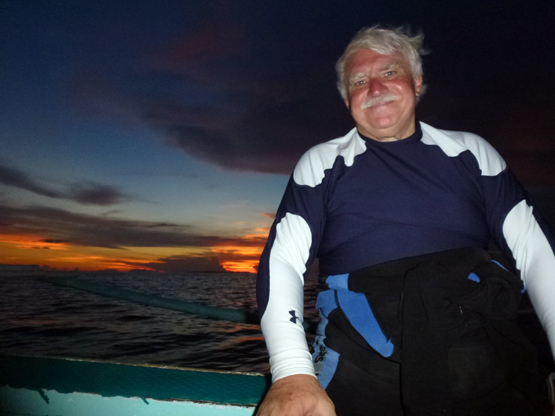 |
Chelidonura mandroroa
Image courtesy of Jim BlackIle Ape Island, Flores, Indonesia
 | Chelidonura mandroroa Gosliner 2011 We first featured this obnoxious looking slug here on the Slug Site as Philinopsis sp. (BOW 462). In Indo-Pacific Sea Slugs we called it Chelidonura sp. 2. Because of its wild coloration Terry Gosliner selected the perfect trivial name - mandroroa. What the heck does this mean you ask? Well, mandroroa is the Malagasy work meaning "to hallucinate." How perfect? The supreme creator must have been hallucinating when he created this beast. Gosliner (2011) states "...The general body color of the living animal (Fig. 1A) is dark brown to black with burnt orange patches and circles each bordered by bright yellow. This pigment pattern is found on the cephalic and posterior shields, the parapodia and the foot. The living animals are elongate, and narrow. The anterior end of the cephalic shield is trilobate. The cephalic shield is triangular, broadest anteriorly and terminates posteriorly with a short rounded lobe. The posterior shield is well rounded anteriorly and terminates in two short, broad posterior lobes that are acutely pointed at their ends. They are approximately equal in length. The parapodia are relatively wide, largely covering most of the cephalic and posterior shields..." Chelidonura mandroroa can be clearly distinguished from all other alglajids by its unique color pattern of a black body with orange patches surrounded by yellow lines. The shape of the anterior portion of the body is most similar to C. inornata (Bill Rudman's Sea Slug Forum), C. electra , , C. castanea, C. punctata and C. amoena , but all of these species have elongate posterior extensions of the posterior shield, while C. mandroroa has short ones. |
While the type locality of this species is Nosy Valiha, Radama Islands, Madagascar it is also known from Japan, Taiwan, Indonesia, Philippines and Tanzania.
Reference:
Gosliner T.M. (2011) Six new species of aglajid opisthobranch mollusks from the tropical Indo-Pacific. Zootaxa 2751: 1-24
Sammamish, WA 98074
Oct., 2013
Send Dave email at davidwbehrens@gmail.com
Jim on location at Anilao, Philippines, May 2013
 |
Jim Black is retired from US Airways after 27 years as a pilot..., flying Captain on an Airbus 330 Internationally. Diving since 1970...with over 7000 dives logged. Shoots Nikon D-300 in Subal Housing with Ikelite strobes. Macro Mate on 105mm for supermacro. Jim's photography has been featured in a number of books and publications including Helmut Debelius' Nudibranchs and Sea Snails of Gosliner, Behrens and Williams Coral Reef Animals of the Indo-Pacific. A photo of Jim petting a shark in "Sleeping Shark Caves" off Isla Mujeres Island, Mexico, taken by Amy Foster his significant other, recently appeared in Dave Behrens' Diving Guide to Cozumel, Cancun & The Riviera Maja.
Jim has been a solid supporter of the Slug Site since day one. His countless contributions put him near the top of the list of photographers who have greatly expanded our knowledge of sea slugs. There are a lot of kids in the formative stage of their education who are getting their first introduction to our sea slug friends via the great photographs Jim and other contributors have made to the site. My hat is off to Jim for making this presentation possible! "...I found Chelidonura mandroroa 2 days in row ...in 25-30 feet of water....in the Flores area towards the end of our Banda Sea Trip in 2011. Perhaps it is common there??? I hadn't seen it in 18 years, the last time being in Lembeh on a dive with Larry Smith and Burt Jones...and I overexposed all the film slides. ARRRGGGHHHH! . Super find again due to that debacle..." Send Jim email at jim.black14@verizon.net
|

|
